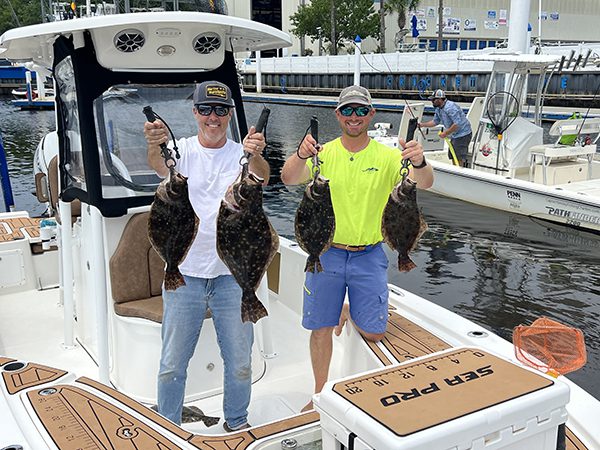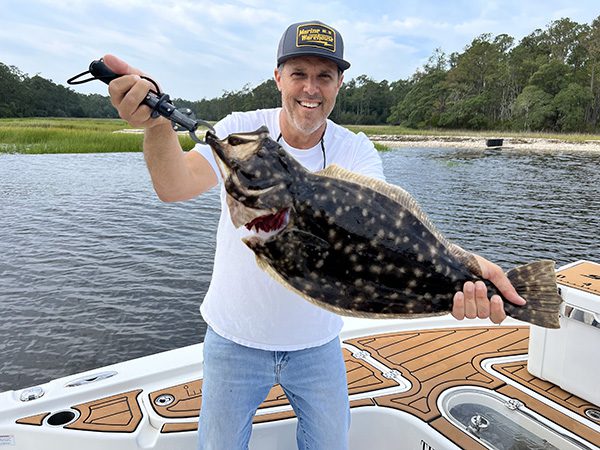Tidelines – June 2023
Last year’s spadefishing trip with Capt. Chris Ossmann, of Fine Catch Fishing Charters out of the North Myrtle Beach and Little River area, turned out to be a high-action, highly successful cobia trip, so when we made plans to try again for spadefish this year, I was already open to other possibilities. Those other possibilities became a reality when the forecast had wind and waves a little too active for spadefish, which typically don’t bite well in anything but calm conditions, but when your captain docks in South Carolina and has already been on a good flounder bite, those “other possibilities” were easy to get excited about.
Chris keeps his boat in Cricket Cove Marina, and as we idled out into the ICW, he told me the plan—if the seas were agreeable enough for us to get out to the Jim Caudle Reef, then we would start with ocean flounder fishing and then finish with inshore flounder fishing, and we already had plenty of mud minnows and soft plastics on board, but he wanted to cast net some pogies as well.

Capt. Chris Ossmann (right), of Fine Catch Fishing Charters, and Gary Hurley with four of the keeper flounder they caught (and didn’t release) using live pogies on Carolina rigs. They were fishing a shelly bottom off a grassline in the South Carolina ICW.
There weren’t any pogies around Cricket Cove, nor in the ICW around the casino boats, so on the way to a place near Calabash, Chris explained why he believed pogies were worth the time to hunt down this morning, “Pogies are a bigger presentation, in some of the darker water they have more of a shine to them, and…flounder just love them.”
Chris’ first throw of the 10-foot cast net gave us almost enough peanut pogies, and then the second throw produced way more than we needed. We filled the livewell with enough to easily get us through a half day of fishing (without over filling and ending up with a bunch of dead pogies halfway through the morning) and headed to the inlet where we saw whitewater and breakers.

Gary Hurley with the 4.9 lb. flounder that hit a live pogie off a small grass point near some oyster rocks. He was fishing the rising tide with Capt. Chris Ossmann, of Fine Catch Fishing Charters out of Cricket Cove Marina in Little River, SC.
“Since we can’t get offshore, I want to start closer to the inlet to see if the fish have pushed out towards the inlet,” Chris said, as we pulled into a creek not far from Little River Inlet. “I want to try this creek first because this creek is one of the places where the flounder are in there first when they move in from the ocean or they’re in there last before they move out to the ocean.”
The twin Power Poles put us in a great position to target a deeper hole flanked by oyster rocks, but after several casts, neither of us could say with confidence that we even had a bump. The place was worth the try, he told me as we moved back out of the creek, but he was ready to move to a section of the waterway where the bite’s been a little more consistent.
“A lot of times when the tide’s real low, especially with negative tides, I look along the shoreline and see areas where you get a lot of scattered shells and transitions to mud,” Chris clarified when I asked him why we were targeting this particular stretch of shoreline in the ICW. “If you can get a scenario where you get scattered shells, and maybe a couple of oyster clusters here and there, that butts up to some sand or mud, the flounder will typically hold in those areas, especially tight up along the shoreline.”
“This area we are going to target,” he continued, “is in between a bunch of oysters and the grassline with scattered shells in between. You’re probably going to get hung up and lose a little tackle, but that’s where the flounder have been.”
He used the GPS spot lock on the trolling motor to hold us in place, explaining that we were going to work the area, move a little, work the area, and move a little until we found fish.
The best success in the previous weeks, including a trip just two days prior, had come from mud minnows, so we both started with mud minnows on a Carolina rig. When the first handful of casts and drags came back empty, Chris switched to a live pogie. Shortly after, he was pulling our first keeper flounder of the day into the waiting landing net.
He had me switch over to pogies, too, and the results were immediate. Just off of a small and subtle point along the grassline, I came tight to my own first keeper flatfish of the day. I put a
second cast just off of the same point and brought in my second keeper, and then on the third cast, I hooked into something that felt significantly heavier than my first two.
After a couple of short bursts immediately after hooking, followed by a couple more short bursts once the fish came close to the boat, Chris and I were celebrating a flounder that would weigh just a pogie shy of five pounds.
“It’s the dragging and dragging and that anticipation of a big thump,” Chris answered when I asked him what he most likes about flounder fishing. “You feel that thump, and when you can tell it’s a solid flounder, that’s enough to get anyone’s blood pumping.”
And for a North Carolina angler waiting and hoping that we will at least get the entire month of September in NC waters to target and keep flounder, my flounder day in South Carolina in May was a huge treat. I’m trying to get on board with the notion of treating flounder in NC like any other sportfish—fun to hook and fight even if you have to let them go—but sportfishing for flounder is nowhere close to hooking and fighting and then putting in the cooler to take home for a family fish fry.
If you’re experiencing NC flounder withdrawal and don’t want to wait until September (fingers crossed), then reach out to Capt. Chris Ossmann, of Fine Catch Fishing Charters, operating out of Cricket Cove Marina in Little River, SC. The minimum size requirement for flounder in SC is 16”, and there’s a five fish per person (10 per boat) limit, but who wouldn’t be happy even taking home a couple of flounder.
You can find out more about Chris and SC flounder fishing, as well as all the different types of trips he offers throughout the year, on his website at www.finecatchfishingcharters.com, or you can give him a call at (843) 655-6440.
I’m still looking forward to the day I catch spadefish with Chris, but right now I’m trying to decide if next year’s spadefish trip will be code for more cobia or flounder, or maybe nearshore gags (hint, hint).





